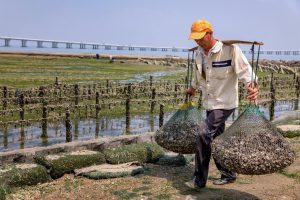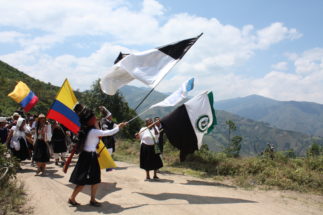Climate change is water change, and this is proving to be starkly true for Nepal. Western Nepal experiences warmer temperatures, a prolonged monsoon, and sporadic and intense rain events, finds the first study to use state-of-the-art modelling to forecast climate change impacts across the Himalayas.
The changes will be more severe than previously expected. Some areas are set to experience more extreme events, such as floods and droughts. These changes could have severe impacts on water supplies, and on the farmers and communities that rely on them.
The Himalayas have been recognised as a hotspot for climate change impacts, as the phenomenon affects higher elevations faster than lower ones. However, there are still very few climate studies aimed at helping Himalayan countries plan for the future.
The changes will be more severe than previously expected. Some areas are set to experience more extreme events, such as floods and droughts.
Within Nepal, the western region has been identified as particularly vulnerable to climate change because of both its biophysical features and the low capacity of its people to adapt. The new research indicates that the highest temperature changes will take place in the mountains, while the greatest fluctuations in precipitation will affect the lower hills and Terai plains.
Getting the full picture
Although extending only around 200 kilometres from north to south, Nepal’s landscape stretches from the highest mountains in the world (at over 8,000 metres) to lowland plains (at around 100 metres above mean sea level). The country hosts many unique geological pockets with their own micro-climates and ecosystems.
This means that traditional global climate models, which forecast change at scales of thousands of kilometres, cannot accurately predict future climate shifts in this area. To help overcome this, the Coordinated Regional Downscaling Experiment for South Asia (CORDEX-SA) is building Regional Climate Models (RCMs) that represent South Asia at a finer scale.
Among the first to put these models to the test, scientists from the International Water Management Institute (IWMI) examined predictions from 19 of the COREX-SA RCMs at near-, mid-, and far-future scenarios. They then compared the results with trends observed in climate data gathered over the past half-century by the Nepal government. And finally, where gaps existed in the data collected by the first two methods, the team interviewed people to gather their perceptions on how the climate had changed over their lifetimes.
The climate assessment revealed that western Nepal can expect even greater change and more variability than reported by global climate models for the wider Hindu Kush Himalayas. And, perhaps most importantly, it indicated that the change would vary even within the region’s different geographical areas. For example, the monsoon was forecast to become wetter in the mountains but drier on the hills and plains, with more extreme climate events affecting both. This suggests that water scarcity could become a pressing issue in the Terai, while faster-melting glaciers from rising temperatures would be the main climate challenge in the mountains. Results from other studies have shown that glacier area already decreased by 25% throughout Nepal, just between 1980 and 2010.
One reason why western Nepal is particularly vulnerable to climate change is its heavy reliance on rainfed farming. Changes to when the monsoon starts and ends, increased temperatures and changing patterns of where and how rain falls all have the potential to disrupt farming cycles. If a particular volume of water falls as rain over a couple of days the soil can absorb it, so crops can make use of it. But if the same amount falls in half a day, it can cause flooding and soil erosion. Changes in weather patterns therefore have a high impact on rainfed farming.
IWMI has earlier studied in detail the climate shocks and responses in the Karnali and Mahakali river basins.
Many of the effects, especially on people living in these basins, have been reported in thethirdpole.net
See:
A journey down the Karnali: Living in fear of floods
Ignoring climate change in the Himalayas
Change and dispossession in western Nepal
On the Mahakali, contractors move in to eat the river
Mahakali women find their voices
Applying the findings
We are now examining how the forecast changes revealed by the climate assessment will affect water availability in western Nepal, and the impacts this may have on specific sectors, including agriculture, tourism and energy. There are plans in the pipeline for large irrigation, hydropower and inter-basin water transfer programmes in Western Nepal, which could potentially be affected. Moreover, with the region’s Karnali river basin forming the headwaters of the Ganga, there are implications for water availability beyond Nepal’s borders, in India and Bangladesh.
In this situation, generating climate futures at sub-national levels enables tailored assessments and subsequent mitigation plans to be put in place before the projections become a devastating reality.
The study marks the first step towards using these state-of-the-art regional climate models to generate detailed climate projections for western Nepal. Our team is also researching future water scenarios in other highly vulnerable developing countries, such as Myanmar, which are often overlooked in the global climate context. With more accurate predictions, we will be better placed to tackle these water challenges together.
![<p>The Mahakali river at the India-Nepal border, downstream of the Sharada barrage [Image by: Joydeep Gupta]</p>](https://dialogue.earth/content/uploads/2020/03/Mahakali_Sharada_barrage_JG.jpg)
![Locals travel home on a wooden boat in the Sundarbans National Park, West Bengal [image: Alamy]](https://dialogue.earth/content/uploads/2020/03/GJEG94-300x200.jpg)




![Downstream of the dam site of the 50 MW Upper Marsyangdi A hydro project in Nygdi. A stretch of about six kilometres has gone dry [All images by: Nabin Baral]](https://dialogue.earth/content/uploads/2020/03/Dying-Marsyangdi-5-300x200.jpg)

